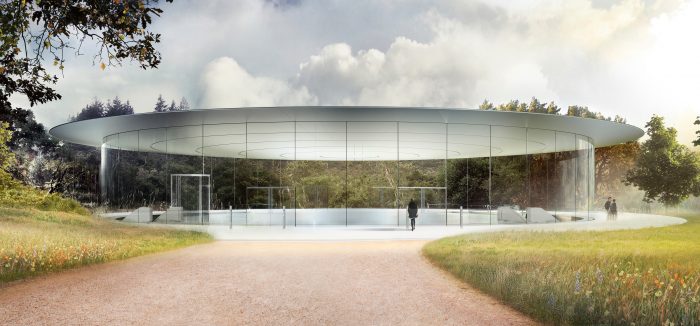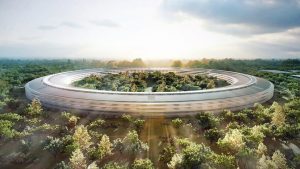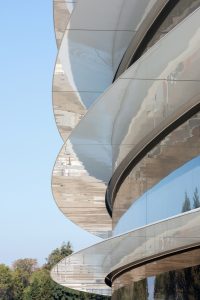Renewable Energy: Apple Park Construction, Tech Leaders Make Huge Strides

Clean energy has been an increasingly important topic in the United States. Recent attacks on the Environmental Protection Agency’s budget have created more fuel for the flame of environmental activism.
Although there’s much confusion and concern, there’s still major progress being made in renewable energy. Private-sector tech leaders such as Google, Amazon, Microsoft and Apple are pushing for 100-percent clean-energy-run operations.
Making headlines and inspiring activists, Apple’s new headquarters, “Apple Park,” has been hailed as the world’s largest building with all-natural ventilation. By the end of April 2017, construction was still being completed, but some of the more than 12,000 members of the Apple crew were starting to be relocated to the 2.8-million-square-foot metropolis.
World’s Largest Naturally Ventilated Building
Located in Cupertino, Calif., Apple Park is massive. It looks like a spaceship with a circular, ring-shaped design and four stories. The new headquarters rests on a 175-acre campus, in the heart of Santa Clara Valley. Apple has taken miles of unremarkable sprawling asphalt and turned it into a haven of greenery. In addition to earning the global title for ventilation, it’s also clad in the world’s largest panels of curved glass. Apple Park has been envisioned as a capital of creativity and collaboration, a beautiful alignment with the highly cultivated Apple culture.
The entire space has been designed to inspire the team while benefiting the environment. Tim Cook, Apple’s CEO, described the building as “luminously designed” to foster creativity. He believes they have achieved the most energy-efficient building of its kind on the planet.
The huge multi-billion-dollar building runs on 100-percent renewable energy. With all of its energy conservation features, they won’t need to use air conditioning or heat for nine months out of the year. As part of its huge renewable energy initiative, Apple Park boasts its own onsite solar installation, featuring 17 megawatts of solar energy—the largest onsite solar facility in the world.
Those who have done their research may be familiar with the Russia Tower skyscraper project that was planned for Moscow. It’s the top result when searching “world’s largest naturally ventilated building.” However, that project has been reported as canceled. Also worth noting, the same architects, London firm Foster + Partners, designed Apple Park. Fosters + Partners architecture thrives on environmental performance. Their building designs are driven by the belief that quality of surroundings has a direct influence on quality of life.
In memory of the iconic Apple founder and leader, a Steve Jobs memorial theater was constructed on the highest hill overlooking meadows and the main building. It’s a 1,000-seat, 165-foot-diameter auditorium created with a futuristic spaceship design; a beautiful 20-foot-tall glass cylinder supports a metallic carbon-fiber roof. With a primary placement in the campus, Jobs’ legacy will be honored through generations of innovative thinkers.
Tech Leaders and Renewable Energy Progression
Apple Park brings renewable energy into the spotlight in a positive way. With tech leaders such as Apple, Google, Facebook and Amazon pushing forward, others will be inspired to do so as well.

In the future, the servers handling Google Maps requests and Gmail needs will use only emissions-free energy. In December 2016, Google committed to using 100-percent renewable energy for 2017. With all the wind and solar power it has been acquiring, the company plans to hit the mark.
In early 2017, Amazon also announced its commitment to clean energy. The company will be installing solar panels in 15 of its fulfillment centers in the United States alone. Amazon executives plan to expand that to 50 solar-fulfillment centers worldwide by 2020.

Amazon now has solar panels at fulfillment centers in California, Delaware, Maryland, Nevada and New Jersey with the capacity to power 80 percent of their needed energy. In addition, Amazon has wind and solar farms in Indiana, Ohio, North Carolina, Texas and Virginia that are powering Amazon Web Services data centers.
Dave Clark, Amazon’s senior vice president of worldwide operations, said they’re looking for global partnerships. With diversity in portfolios, he believes they can easily attain a win-win scenario with low business costs and savings for customers.
Social media giant Facebook also has been scoring well in Greenpeace, earning a “radical improvements in transparency” report. To further the company’s green goals, it has data centers in Clonee, Ireland, and Los Lunas, N.M., being constructed to run entirely on clean energy.
Why Renewable Energy Operations Make Sense
These tech leaders are moving toward renewable energy, because it’s more than just an excellent public image. Renewable energy is getting cheaper, providing clear benefits for a company’s bottom line. Since 2012, solar energy prices have dropped 80 percent. Similarly, wind power has dropped 60 percent. Solar and wind power are starting to compete with natural gas and coal for affordability as well as accessibility. In addition, clean energy is great for companies managing their future expenses. Wind and solar projects typically are certified on 10- or 20-year contracts.
Overall, tech companies are making huge progress in clean energy. They have accounted for two-thirds of all corporate renewable deals since 2010. Last year, renewable-energy investments hit a record at $286 billion, which helped drive costs down. With cheaper costs and inspiring leaders, renewables are more appealing than ever.
About Todd Danielson
Todd Danielson has been in trade technology media for more than 20 years, now the editorial director for V1 Media and all of its publications: Informed Infrastructure, Earth Imaging Journal, Sensors & Systems, Asian Surveying & Mapping, and the video news portal GeoSpatial Stream.


